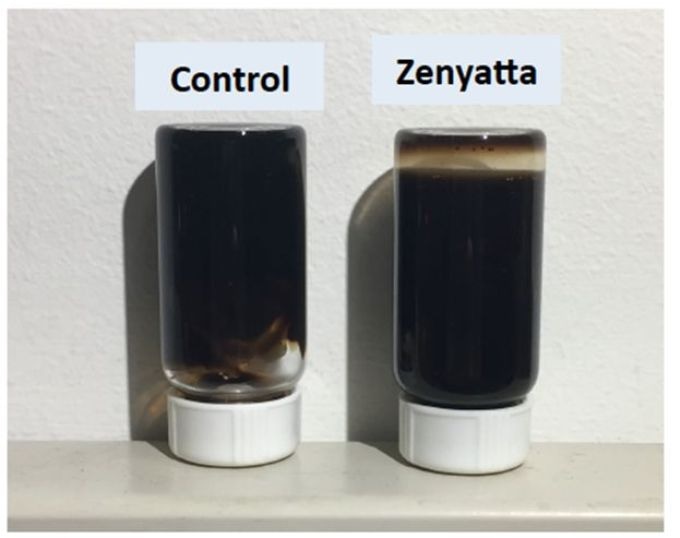May 17 2017
 Figure shows a lower viscosity for Zenyatta graphene oxide compared to the control sample in a recent test at the U.S.Co. As seen in the figure, after turning the sample vial upside down, the Zenyatta sample has settled at the bottom due to lower viscosity while the control material has not yet done so. The lower viscosity enables easier processing of Zenyatta's graphene oxide.(credit: Zenyatta Ventures)
Figure shows a lower viscosity for Zenyatta graphene oxide compared to the control sample in a recent test at the U.S.Co. As seen in the figure, after turning the sample vial upside down, the Zenyatta sample has settled at the bottom due to lower viscosity while the control material has not yet done so. The lower viscosity enables easier processing of Zenyatta's graphene oxide.(credit: Zenyatta Ventures)
Recently, Zenyatta Ventures reported the successful testing of their graphene oxide material by a top U.S. based advanced materials company manufacturing silicon-graphene anodes for the next generation of lithium-ion batteries.
Primary results reveal ease of processing using Zenyatta’s graphene oxide and similar electrochemical performance compared to the control material that is presently being used by the U.S. Company. The excellent dispersion qualities and good electrochemical performance of the Zenyatta’s graphene oxide are necessary properties for this silicon-graphene battery application. Dr. Aicheng Chen, Professor at Lakehead University recently converted Zenyatta’s high-purity graphite into graphene oxide, and then sent it to the U.S. Company for analysis as an advanced nanomaterial in a new lithium-ion battery.
Lithium-ion batteries are extensively used worldwide for electric vehicles and portable electronic devices. Unfortunately, lithium-ion batteries still lack the needed level of energy storage to fully meet the demands of such applications as electric vehicles. A new silicon-graphene composite anode enables faster charging batteries and better capacity that could meet consumer demand for increasing range and power.
Given the present limitations on the existing lithium-ion battery, the World needs to develop a super-battery. Silicon-graphene is the next generation anode being developed for batteries by many advanced material companies. Zenyatta’s graphene oxide has properties that make it a suitable material to be used with silicon in these next generation Lithium-ion batteries. While silicon has many times the capacity of graphite, it cannot be used alone due to rapid degradation. A significant amount of research has been carried out to encapsulate silicon in a graphene material to enhance the cycle life while also increasing charge capacity and durability for advanced lithium-ion batteries. We are very excited with the potential of our graphene to play a key role as a component of the next generation batteries. The adaption of silicon-graphene based anode batteries could further accelerate the fast growing market for energy storage, especially for the automotive sector. Having a consistent and high quality raw material source in North America for an end-user’s supply chain is critical in order to maintain long term quality control for product specifications.
Aubrey Eveleigh, President and CEO, Zenyatta
The U.S. Company will continue conducting advanced testing on Zenyatta’s graphene oxide for use in Lithium-ion anode composite material. Further testing will include the determination of the following:
- Compatibility with processing technique and yield;
- Aqueous dispersion quality;
- Electrochemical performance; and,
- Characterization of the composite material.
Zenyatta Ventures is involved in developing the Albany Graphite Deposit in northeastern Ontario, Canada. The deposit is a unique type of igneous-hosted, fluid-derived graphite mineralization possessing highly crystalline carbon in two large breccia pipes. Zenyatta is partnering with a number of companies in Europe, Asia, and North America using its high purity graphite for Lithium-ion batteries, fuel cells and graphene. The outlook for the worldwide graphite and graphene market is highly promising with demand mounting quickly from new applications. It is currently thought to be one of the more strategic elements by a number of leading industrial nations, mainly for its growing importance in high technology manufacturing and in the emerging “green” industries such as electric vehicle parts.
The Albany graphite deposit is located 30 km north of the Trans-Canada Highway, power line and natural gas pipeline near the communities of Hearst and Constance Lake First Nation. A rail line is located 70 km away with an all-weather road approximately 10 km from the graphite deposit. The world trend is to develop nano-material products for technological applications that need extraordinary performance using ultra-high purity graphite powder at an affordable cost. Albany graphite can be upgraded to ~99.9% C with very good crystallinity without the use of aggressive acids (hydrofluoric) or high temperature thermal treatment therefore having an environmental advantage over other types of upgraded high-purity graphite material.
Mr. Aubrey Eveleigh, P.Geo., Zenyatta’s President and CEO, is the “Qualified Person” for the purposes of National Instrument 43-101 and has reviewed, prepared and supervised the preparation of the technical information contained in this news release.